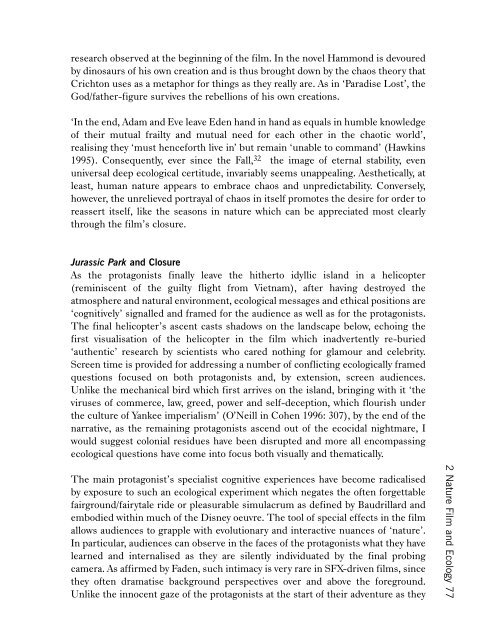Hollywood Utopia
Hollywood Utopia
Hollywood Utopia
Create successful ePaper yourself
Turn your PDF publications into a flip-book with our unique Google optimized e-Paper software.
esearch observed at the beginning of the film. In the novel Hammond is devoured<br />
by dinosaurs of his own creation and is thus brought down by the chaos theory that<br />
Crichton uses as a metaphor for things as they really are. As in ‘Paradise Lost’, the<br />
God/father-figure survives the rebellions of his own creations.<br />
‘In the end, Adam and Eve leave Eden hand in hand as equals in humble knowledge<br />
of their mutual frailty and mutual need for each other in the chaotic world’,<br />
realising they ‘must henceforth live in’ but remain ‘unable to command’ (Hawkins<br />
1995). Consequently, ever since the Fall, 32 the image of eternal stability, even<br />
universal deep ecological certitude, invariably seems unappealing. Aesthetically, at<br />
least, human nature appears to embrace chaos and unpredictability. Conversely,<br />
however, the unrelieved portrayal of chaos in itself promotes the desire for order to<br />
reassert itself, like the seasons in nature which can be appreciated most clearly<br />
through the film’s closure.<br />
Jurassic Park and Closure<br />
As the protagonists finally leave the hitherto idyllic island in a helicopter<br />
(reminiscent of the guilty flight from Vietnam), after having destroyed the<br />
atmosphere and natural environment, ecological messages and ethical positions are<br />
‘cognitively’ signalled and framed for the audience as well as for the protagonists.<br />
The final helicopter’s ascent casts shadows on the landscape below, echoing the<br />
first visualisation of the helicopter in the film which inadvertently re-buried<br />
‘authentic’ research by scientists who cared nothing for glamour and celebrity.<br />
Screen time is provided for addressing a number of conflicting ecologically framed<br />
questions focused on both protagonists and, by extension, screen audiences.<br />
Unlike the mechanical bird which first arrives on the island, bringing with it ‘the<br />
viruses of commerce, law, greed, power and self-deception, which flourish under<br />
the culture of Yankee imperialism’ (O’Neill in Cohen 1996: 307), by the end of the<br />
narrative, as the remaining protagonists ascend out of the ecocidal nightmare, I<br />
would suggest colonial residues have been disrupted and more all encompassing<br />
ecological questions have come into focus both visually and thematically.<br />
The main protagonist’s specialist cognitive experiences have become radicalised<br />
by exposure to such an ecological experiment which negates the often forgettable<br />
fairground/fairytale ride or pleasurable simulacrum as defined by Baudrillard and<br />
embodied within much of the Disney oeuvre. The tool of special effects in the film<br />
allows audiences to grapple with evolutionary and interactive nuances of ‘nature’.<br />
In particular, audiences can observe in the faces of the protagonists what they have<br />
learned and internalised as they are silently individuated by the final probing<br />
camera. As affirmed by Faden, such intimacy is very rare in SFX-driven films, since<br />
they often dramatise background perspectives over and above the foreground.<br />
Unlike the innocent gaze of the protagonists at the start of their adventure as they<br />
2 Nature Film and Ecology 77
















